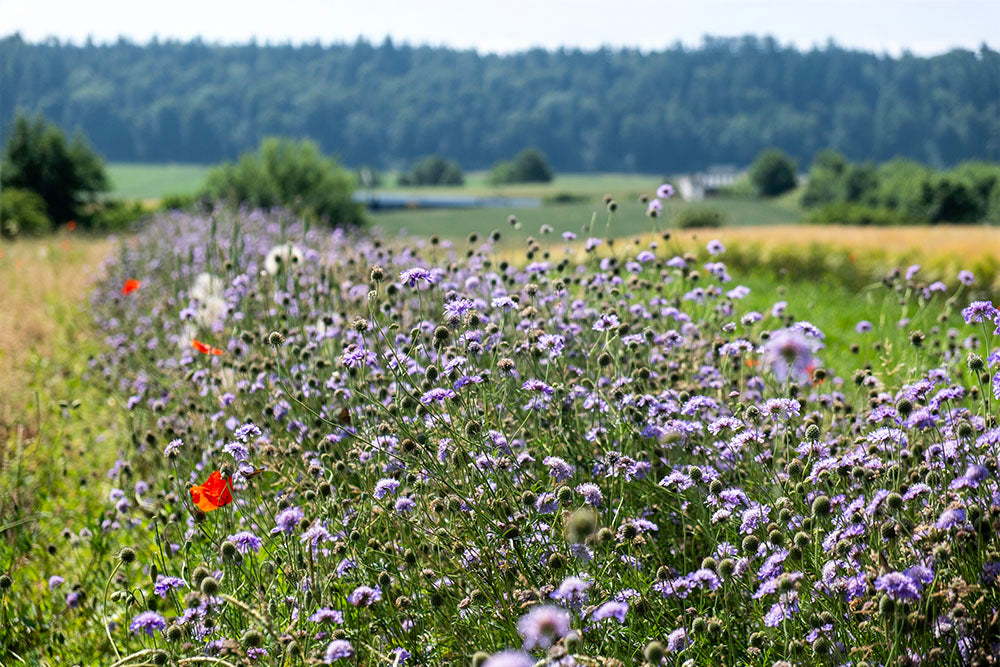
A Growing Thank You for a Wildly Successful Start
These seeds are our way of saying thank you - and giving something back to the nature we love.
Wildflowers for Biodiversity
A Thank You That Grows
We’re overwhelmed - in the best way.
The incredible support for our Kickstarter launch came faster than expected, and we couldn’t be more grateful. As an honest thank you, every backer will receive something special alongside their Nola product: a small bag filled with meaning - and with seeds.

Inside, you’ll find a hand-selected mix of rare wildflowers, native to the region of Schaffhausen in northern Switzerland. These species aren’t just beautiful - they’re disappearing. That’s why we teamed up with Gabi Uehlinger from Neunkirch, who continues her family's work in seed conservation and regional biodiversity in the second generation. Together, we chose a blend that helps restore what has quietly faded: habitat for wild bees, beetles, and the many small creatures we often overlook. More information and an interview with Gabi will come – keep your eyes open on other media channels where Nola is present.
By sowing these seeds, you’re not only making a visual statement - you’re giving back to the ecosystems we all depend on.
Where and how to sow:
If you're in the Swiss Plateau or southern Germany, you can plant them directly along field edges, in low-nutrient meadows, or a garden bed. Just sprinkle, cover lightly with soil, and let nature do the rest.
If you live elsewhere in Europe:
Because these plants are endemic to our region, we kindly ask that you don’t sow them in open natural areas. A balcony box or backyard garden is perfect - and your local pollinators will still appreciate the gesture.
Thank you for helping us grow Nola - and something even bigger along with it.

About the Wildflowers in This Mix
While all of them support biodiversity and pollinator habitats, some are endangered to some more commonly found species:
- Corncockle (DE: Kornrade) (Agrostemma githago): Once common in cereal fields, this striking pink flower has become critically endangered due to modern seed cleaning and herbicide use. In many areas, it is considered locally extinct. Reintroduction efforts through seed projects are essential to its survival.
- Thorow-wax (DE: Hasenohr) (Bupleurum rotundifolium): A true rarity in modern landscapes, this plant with rounded leaves and small yellow-green flowers is highly specialized and endangered, largely due to changes in traditional farming. It thrives on dry, nutrient-poor soils that are now uncommon.
- Annual Woundwort (DE: Einjähriger Ziest) (Stachys annua): Native to field edges and open, disturbed ground, this low-growing herb is increasingly rare due to habitat loss. Its small flowers are valuable for pollinators, especially solitary bees.
- Field Larkspur (DE: Rittersporn) (Consolida regalis): A classic of old-fashioned grain fields, this beautiful purple-blue flower has declined sharply across Europe. Still found in isolated pockets, it is considered vulnerable and relies on targeted conservation to remain present.
- Scarlet Pimpernel (DE: Blauer Gauchheil) (Anagallis foemina):Known for its vivid blue flowers, this small annual is sensitive to soil disturbance and fertilization. Though not yet critically rare, its populations are declining in intensively managed landscapes.
- Gold-of-Pleasure (DE: Leindotter) (Camelina sativa): A traditional oilseed crop now rarely cultivated, Leindotter was once common in mixed farming systems. Though it still occurs in niche projects, it is considered a relic of pre-industrial agriculture.
- Cornflower (DE: Kornblumen) (Centaurea cyanus): Once declining, the iconic blue cornflower is seeing a resurgence thanks to its popularity in wildflower mixes. While no longer critically endangered, it remains an important species for supporting insect diversity.
- Poppy (DE: Mohn) (Papaver rhoeas): Bright red and resilient, poppies have adapted well to modern environments. While still a symbol of once-diverse fields, they are relatively widespread today – especially in urban and garden settings.
- Snapdragon (DE: Löwenmaul) (Antirrhinum majus): Originally native to southern Europe, wild snapdragons are rarely found in the wild north of the Alps. In our region, they mostly occur as garden escapees or are included intentionally in seed mixes for their color and pollinator appeal.
